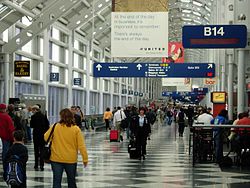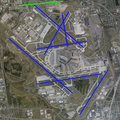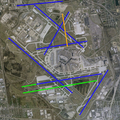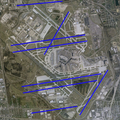O'Hare International Airport
This article may require copy editing for grammar, style, cohesion, tone, or spelling. |
Template:Airport frame Template:Airport title Template:Airport image Template:Airport infobox Template:Runway title Template:Runway Template:Runway Template:Runway Template:Runway Template:Runway Template:Runway Template:Airport end frame
O'Hare International Airport (IATA: ORD, ICAO: KORD) is an airport located in Chicago, Illinois, 17 miles (27 km) northwest of the Chicago Loop. It is the largest hub of United Airlines (whose headquarters will soon move from nearby Elk Grove Township to downtown Chicago) and the second-largest hub of American Airlines (after Dallas/Fort Worth). It is operated by the City of Chicago Department of Aviation, associated with an umbrella regional authority.
Prior to 2005, O'Hare was the world's busiest airport in terms of takeoffs and landings. That year, mainly due to limits imposed by the federal government to reduce flight delays at O'Hare[1], Hartsfield-Jackson Atlanta International Airport became the busiest. O'Hare currently accounts for over a sixth of the nation's total flight cancellations. This airport is currently the worst airport for on-time departures of any major US airport[2]. O'Hare also has a strong international presence, with flights to more than 60 foreign destinations. O'Hare was ranked fourth in 2005 of the United States' international gateways, with only JFK International Airport in New York City, LAX in Los Angeles, and Miami International Airport serve more foreign destinations. O’Hare International Airport was voted the Best Airport in North America for the year 2003 by readers of the U.S. Edition of Business Traveler Magazine, marking six years in a row O'Hare has earned top honor.
Although O'Hare is Chicago's chief airport, Midway Airport, Chicago's secondary airport, is closer to the Loop than O'Hare.
History
The airport was constructed in 1942-43 as a manufacturing plant for Douglas C-54s during World War II. The site was chosen for its proximity to the city and transportation. The two million square-foot (180,000 m²) factory needed easy access to the workforce of the nation's then-second-largest city, as well as its extensive railroad infrastructure. Orchard Place was a small pre-existing community in the area, and the airport was known during the war as Orchard Place Airport/Douglas Field. The facility was also the site of the Army Air Force's 803 Special Depot, which stored many rare or experimental planes, including captured enemy aircraft. These historic aircraft would later be transferred to the National Air Museum, going on to form the core of the Smithsonian Air and Space Museum's collection.

The Older Tower (left) is now used as a Ground Control System.
Douglas Aircraft Company's contract ended in 1945, and though plans were proposed to build commercial aircraft, the company ultimately chose to concentrate production on the west coast. With the departure of Douglas, the airport took the name Orchard Field Airport. In 1945, the facility was chosen by the City of Chicago as the site for a facility to meet future aviation demands. Though its familiar three-letter IATA code ORD still reflects the early identity of the airport, it was renamed in 1949 after Lt. Cmdr. Edward "Butch" O'Hare, a World War II flying ace who was awarded the Medal of Honor.
By the early 1950s, Midway Airport, which had been the primary Chicago airport since 1931, had become too small and crowded despite multiple expansions and was unable to handle the planned first generation of jets. The City of Chicago and FAA began to develop O'Hare as the main airport for Chicago's future. The first commercial passenger flights were started there in 1955, and an international terminal was built in 1958, but the majority of domestic traffic did not move from Midway until completion of a 1962 expansion of O'Hare. The arrival of Midway's former traffic instantly made O'Hare the new World's Busiest Airport, serving 10 million passengers annually. Within two years that number would double, with more people passing through O'Hare in 12 months than Ellis Island had processed in its entire existence. In 1997, annual passenger volume was 70 million.
O'Hare Airport is municipally connected to the city of Chicago via a narrow strip of land under the Kennedy Expressway. This land was added to the city limits in the 1950s to assure the airport was contiguous with the city to keep it under city control. The land was condemned then annexed instantly by the city before surrounding suburbs even knew what happened to keep them from interfering with the city's plans for growth at the airport.[citation needed] The CTA Blue Line was extended to the airport in the 1980s.
Incidents
On May 25, 1979, American Airlines Flight 191 crashed upon takeoff en route to Los Angeles International Airport in Los Angeles, California from Chicago, killing all 271 people on board and two people on the ground. The crash remains the deadliest single-aircraft crash in United States history.
On May 8, 2002, alleged Al-Qaida member Jose Padilla was arrested after his plane landed at the airport for allegedly being a scout for a plot to plant a dirty bomb.
Modernization plan
O'Hare's high volume and crowded schedule can lead to cancellations and long delays that affect air travel across the United States. Official reports rank O'Hare as the least punctual airport in the United States based on percentage of delayed flights. United Airlines and American Airlines have recently agreed to modify their schedules to help reduce congestion caused by clustered arrivals and departures. Because of the air traffic departing, arriving, and near the airport, the air traffic controllers at O'Hare and its nearby facilities are some of the hardest working in the world in terms of number of controlled flights per hour.
City management has committed to a $6 billion capital investment plan to increase the airport's capacity by 60% and decrease delays by an estimated 79 percent[3]. This plan was approved by the FAA in October 2005 and will involve a reconfiguration of the airfield and addition of terminal space. Four runways will be added and three decommissioned in order to give the airfield an eight-runway parallel configuration similar to those in Dallas. Terminals 3 and 5 will undergo expansion, and a new west terminal is planned with western access into the airport; however, some land acquisition is necessary, requiring approximately 2,800 residents to be relocated. The program will expand the airport's capacity to over 3,800 operations per day, up from the present capacity of 2,700 and will vastly increase passenger throughput capacity:
-
Phase 1 of the modernization program
-
Phase 2
-
Phase 3
-
Final runway configuration
Resistance and alternatives
The neighboring communities of Bensenville and Elk Grove Village have been centers of resistance to the expansion plan. The towns will lose homes and businesses as a result of the expansion. Together, they have formed the Suburban O'Hare Commission [4] to fight the expansion. So far their success has been modest, but the commission did receive a temporary injunction against the city's expansion project, which the FAA already green-lighted. The Suburban O'Hare Commission has also been instrumental in pushing for a third regional airport in south suburban Peotone, which they claim would alleviate the problems at O'Hare.
In 1995 the Chicago Gary Airport Compact was signed by the cities of Chicago and Gary, Indiana, creating the governing body of the Gary/Chicago International Airport just across the state line. While markedly smaller than the proposed Peotone site, this airport already has an active runway longer than the longest at Midway Airport, and is miles closer to the population in greatest need of access to air transport. However, the state of Illinois does not appear interested in expanding an airport across state lines. This may not be much of an issue as the airport is already in the process of letting bids for lengthening the main runway, financed in part by federal grant monies.
Terminals and Airlines
O'Hare International has four passenger terminals. Two or more additional terminal buildings are envisioned. There is the possibility of a large terminal complex for the west side of the field, with access from I-90 and/or the Elgin-O'Hare Expressway, if the runway reconfiguration is completed.
In October 2006, JetBlue Airways applied to the FAA for landing rights at Chicago's O'Hare Airport for 8 flights per day.[5] On October 16, 2006, JetBlue received approval from the FAA to land at Ohare, though the number of landing slots requested was cut in half to 4 flights per day.[6]
Terminal 1 (United Airlines Terminal: Concourses B and C)
Note: International Arrivals are Handled in Terminal 5.



- All Nippon Airways (Tokyo-Narita) [starts October 29, 2006]
- Lufthansa (Frankfurt, Munich)
- United Airlines (Albany, Amsterdam, Anchorage, Aruba, Atlanta, Baltimore/Washington, Beijing, Bermuda, Boise, Boston, Bozeman [seasonal], Buffalo, Burlington, Calgary, Charlotte, Cincinnati/Northern Kentucky, Cleveland, Columbus, Cozumel, Dallas/Fort Worth, Dayton, Denver, Des Moines, Detroit, Frankfurt, Grand Cayman, Grand Rapids, Greensboro, Harrisburg, Hartford, Hong Kong, Honolulu, Houston-Intercontinental, Indianapolis, Jackson Hole, Kahului, Kansas City, Kona, London-Heathrow, Los Angeles, Manchester (NH), Mexico City, Minneapolis/St. Paul, Montego Bay, Munich, New York-LaGuardia, Newark, Oakland, Oklahoma City, Omaha, Orange County, Osaka-Kansai, Paris-Charles de Gaulle, Philadelphia, Pittsburgh, Portland (OR), Providence, Puerto Vallarta, Richmond, Rochester (NY), Sacramento, St. Louis, St. Thomas, Salt Lake City, San Antonio, San Diego, San Francisco, San Jose (CA), San Jose del Cabo, San Juan, Sao Paulo-Guarulhos, Seattle/Tacoma, Seoul-Incheon, Shanghai-Pudong, Singapore, Spokane, Taipei-Taiwan Taoyuan, Tokyo-Narita, Toronto, Tucson, Vancouver, Washington-Dulles, Washington-Reagan, West Palm Beach, Winnipeg)
- Ted operated by United Airlines (Cancún, Fort Lauderdale, Las Vegas, Miami, Orlando, Phoenix, Puerto Vallarta (starts December 14, 2006), San Jose del Cabo, San Juan, Tampa)
- United Express operated by Chautauqua Airlines (Buffalo, Indianapolis, Louisville, Rochester (NY), South Bend, Syracuse)
- United Express operated by GoJet Airlines (Cincinnati/Northern Kentucky, Jacksonville (FL), Manchester (NH), Omaha, St. Louis, San Antonio, Syracuse, Tulsa)
- United Express operated by Mesa Airlines (Allentown/Bethlehem, Atlanta, Appleton, Austin, Boise, Calgary, Cedar Rapids/Iowa City, Charlotte, Cleveland, Colorado Springs, Columbia, Columbus, Daytona Beach, Des Moines, Grand Rapids, Greenville (SC), Kansas City, Manchester (NH), Memphis, Milwaukee, Nashville, Raleigh/Durham, Rochester (NY), Savannah, South Bend, Syracuse, Traverse City, Tulsa, Wichita, Wilkes-Barre/Scranton)
- United Express operated by Shuttle America (Albany, Albuquerque, Buffalo, Cedar Rapids/Iowa City, Columbus, Dallas/Fort Worth, Des Moines, Fort Myers, Grand Rapids, Hartford, Houston-Intercontinental, Indianapolis, Kansas City, Minneapolis/St. Paul, Montréal, Myrtle Beach, New Orleans, Ottawa, White Plains)
- United Express operated by SkyWest (Akron, Allentown/Bethlehem, Appleton, Austin, Birmingham (AL), Burlington, Cedar Rapids/Iowa City, Charleston (WV), Cincinnati/Northern Kentucky, Cleveland, Colorado Springs, Columbus, Dayton, Des Moines, Edmonton, Fargo, Fayetteville (AR), Fort Wayne, Grand Rapids, Houston-Intercontinental, Indianapolis, Jacksonville (FL), Kalamazoo, Kansas City, Knoxville, Lansing, Lexington, Lincoln, Louisville, Memphis, Milwaukee, Moline, Nashville, Norfolk, Omaha, Peoria, Pittsburgh, Providence, Roanoke, Saginaw, Salt Lake City, San Antonio, Savannah, Sioux Falls, South Bend, Springfield (MO), Syracuse, Traverse City, Tulsa, Wausau/Stevens Point, Wichita, Wilkes-Barre/Scranton)
- United Express operated by Trans States Airlines (Albany, Bloomington, Burlington, Harrisburg, Madison, Manchester (NH), Milwaukee, Moline, Montréal, Omaha, Portland (ME), Raleigh/Durham, Richmond, St. Louis, South Bend, Syracuse, White Plains)
The original 1955 passenger terminal for international flights, was replaced with the modern Terminal 1, designed by Helmut Jahn, in 1987.
Terminal 2 (Concourses E and F)
- Air Canada (Montréal, Toronto, Ottawa)
- Continental Airlines (Houston-Intercontinental, Newark)
- Continental Express operated by ExpressJet Airlines (Cleveland, Houston-Intercontinental, Newark)
- JetBlue Airways (Long Beach, New York-JFK) [starts January 4, 2007]
- Northwest Airlines (Detroit, Memphis, Minneapolis/St. Paul)
- United Airlines
- United Express (See above)
- US Airways (Charlotte, Philadelphia, Phoenix, Pittsburgh)
- US Airways operated by America West Airlines (Las Vegas, Phoenix)
- US Airways Express operated by Air Wisconsin (Pittsburgh)
- US Airways Express operated by Republic Airlines (Philadelphia, Pittsburgh)
Terminal 2 was built in a large airport expansion in 1962, along with the original portion of Terminal 3.
Terminal 3 (Concourses G, H, K, and L)
Note: International Arrivals are Handled in Terminal 5.


- Alaska Airlines (Anchorage, Seattle/Tacoma)
- American Airlines (Acapulco, Albuquerque, Atlanta, Austin, Baltimore/Washington, Boston, Brussels, Calgary [seasonal], Cancún, Dallas/Fort Worth, Delhi, Denver, Detroit, Dublin, El Paso, Fayetteville (AR), Fort Lauderdale, Fort Myers, Frankfurt, Hartford, Honolulu, Houston-Intercontinental, Indianapolis, Jackson Hole, Kansas City, Las Vegas, London-Heathrow, Los Angeles, Manchester (UK), Maui, Mexico City, Miami, Minneapolis/St. Paul, Montréal, Nashville, New Orleans, Newark, New York-LaGuardia, Orange County, Orlando, Palm Springs, Paris-Charles de Gaulle, Philadelphia, Phoenix, Portland (OR), Providence, Puerto Vallarta, Raleigh/Durham, Reno/Tahoe, Rome-Fiumicino [seasonal], St. Louis, Salt Lake City, San Antonio, San Diego, San Francisco, San Juan, San Jose (CA) San Jose del Cabo, Seattle/Tacoma, Shanghai-Pudong, Shannon, Tampa, Tokyo-Narita, Toronto, Tucson, Tulsa, Vail, Vancouver [seasonal], Washington-Reagan, West Palm Beach, White Plains)
- American Eagle (Albany, Atlanta, Bloomington, Buffalo, Cedar Rapids/Iowa City, Champaign/Urbana, Charlotte, Chattanooga, Cincinnati/Northern Kentucky, Cleveland, Colorado Springs, Columbia, Columbus, Dayton, Des Moines, Dubuque, Evansville, Fayetteville (AR), Flint, Fort Wayne, Grand Rapids, Green Bay, Greensboro, Greenville (SC), Harrisburg, Huntsville, Indianapolis, Jackson, Jacksonville, Kalamazoo, Knoxville, La Crosse, Little Rock, Lexington, Louisville, Madison, Marquette, Memphis, Milwaukee, Minneapolis/St. Paul, Moline, Nashville, Nassau, New York-JFK, Newburgh, Norfolk, Oklahoma City, Omaha, Ottawa, Pensacola, Peoria, Pittsburgh, Richmond, Rochester (MN), Rochester (NY), Savannah, Springfield (MO), Syracuse, Toledo, Traverse City, Tulsa, Washington-Dulles, White Plains, Wichita)
- Delta Air Lines (Atlanta, Salt Lake City)
- Delta Connection operated by Comair (Cincinnati/Northern Kentucky, New York-JFK)
- Delta Connection operated by Shuttle America (New York-LaGuardia)
- Iberia (Madrid)
- Spirit Airlines (Fort Lauderdale, Fort Myers, Las Vegas, Los Angeles, Orlando, Tampa)
Terminal 3 was also built in the 1962 capital program. It was significantly expanded in 1983, with the construction of Concourse L. It is currently undergoing renovation, scheduled to run from January 2004 to Late Fall 2007.
Terminal 4
Terminal 4 was O'Hare's interim international terminal from 1984 until 1995, located on the ground floor of the main parking garage. International passengers would check in at Terminal 4 and be taken directly to their aircraft by bus. Since the opening of Terminal 5, Terminal 4 has been changed into the airport's facility for CTA buses, hotel shuttles, and other ground transportation. The T4 designation will be used again in the future as new terminals are developed.
Terminal 5 - International Terminal (Concourse M)

International Terminal
Terminal 5 handles all international arrivals at O'Hare (excluding airports with border preclearance), as well as the following departing flights:
- Aeroméxico (Mexico City)
- Aer Lingus (Dublin, Shannon)
- Air France (Paris-Charles de Gaulle)
- Air India (Bangalore, Delhi, Frankfurt, London-Heathrow, Mumbai)
- Air Jamaica (Montego Bay)
- Alitalia (Milan-Malpensa)
- Asiana Airlines (Seoul-Incheon)
- Austrian Airlines (Vienna) [Begins April 4, 2007]
- bmi (Manchester (UK))
- British Airways (London-Heathrow)
- Cayman Airways (Grand Cayman)
- El Al (Tel Aviv)
- Japan Airlines (Tokyo-Narita)
- KLM Royal Dutch Airlines (Amsterdam)
- Korean Air (Seoul-Incheon)
- LOT Polish Airlines (Krakow, Warsaw)
- Mexicana (Guadalajara, León, Mexico City, Monterrey, Morelia, Zacatecas)
- Oasis Hong Kong Airlines (Hong Kong) [Coming Soon]
- Pakistan International Airlines (Islamabad, Karachi, Lahore, Manchester (UK))
- Royal Jordanian Airlines (Amman)
- SAS (Copenhagen, Stockholm-Arlanda)
- Swiss International Air Lines (Zurich)
- TACA (Guatemala City, San Salvador)
- Turkish Airlines (Istanbul-Atatürk)
- USA 3000 (Fort Myers, Montego Bay, Orlando, Punta Cana, St. Petersburg (FL))
Airfield

There are 6 primary air carrier runways, arranged tangentially in 3 pairs of parallel sets. The largest is Runway 14R-32L, 13,000' x 200'. Runways 14L, 14R, 27L and 27R have Category III ILS (Instrument Landing System). All other runways except 4L have full ILS.
Three runways of the original 1943 airfield's four have been upgraded to modern standards. Additional runways were constructed in 1955, 1968, and 1971. In 2003, old Runway 18-36 was permanently closed -- its short length and problematic placement no longer justified its continued certification. Runway 18-36 is now shown as taxiway GG on current airport charts.
The proposed redevelopment would entail removal of the 2 northwest-southeast runways, construction of 4 additional east-west runways, and extension of the 2 existing east-west runways. The two existing northeast-southwest runways would be retained.
Runway 32L is sometimes used for departures in a shortened configuration. Planes access the runway from its intersection at taxiway T10 (common) or taxiway M (not common). This shortens the effective length of the runway but allows operations on runway 9R-27L to continue.
Transit
- Road vehicles enter and exit via I-190, which branches off I-90 (the Kennedy Expressway) leading to downtown Chicago. Cars may also access the airport locally from Mannheim Road, the airport's eastern boundary. Aside from cargo access on its south side, all airport traffic travels through the east side of the airport.
- Trains from the Blue Line of the CTA's "L" depart the terminal from an underground station that opened on September 2, 1984.
- The VAL ATS (Airport transit system) which was constructed in 1993 connects Terminals 1, 2, 3, and 5 with long-term parking. The ATS runs 24 hours a day, with trains every 3-6 minutes.
Other facilities
A large air cargo complex on the southwest side of the field was opened in 1984, replacing most of the old cargo area, which stood where Terminal 5 now exists.
The original Douglas plant on the northeast side evolved into an Air National Guard and Air Force Reserve facility, but this was closed in 1998 and is now being redeveloped for cargo and general aviation. Signature Flight Support services private aircraft in this area.
The hangar area has multiple buildings capable of fully enclosing aircraft up to the size of the Boeing 747.
Cargo carriers
- Aeromexpress
- Air China (Anchorage, Beijing) (Service Stops Only)
- Atlas Air
- Cargo 360
- Cathay Pacific (Hong Kong)
- China Airlines (Anchorage, Taipei-Taiwan Taoyuan)
- DHL
- Emery Worldwide
- EVA Air (Taipei-Taiwan Taoyuan)
- Federal Express
- Gemini Air Cargo
- Kalitta Air
- Martinair (Amsterdam)
- NWA Cargo (Anchorage, Tokyo-Narita)
- Nippon Cargo Airlines (Tokyo-Narita)
- Polar Air Cargo
- Tarom Cargo (Bucharest-Otopeni)
- UPS
- Singapore Airlines Cargo (Singapore)
Cultural References
O'Hare has been referenced by many movies, T.V. shows and songs
- Christmas Vacation: Clark Griswold says that Santa Claus has been spotted by air traffic controllers at O'Hare.
- O'Hare was frequently referenced in the T.V. show LAX.
- Meet the Parents & Meet the Fockers: Greg Focker departs O'Hare on his way to New York.
- My Best Friend's Wedding: Julia Roberts' character meets her friend's fiancée at O'Hare.
- Planes, Trains & Automobiles: Steve Martin is trying to get back to O'Hare in the hit comedy.
- Home Alone 1 & 2: The McAllisters live in a suburb of Chicago and are seen departing from O'Hare in both movies.
- Risky Business: There is a scene where Joel takes his parents to O'Hare; nice highway approach shots and inside the ticketing area.
- Alkaline Trio's track 'You're Dead' from the 2001 album From Here To Infirmary includes the line "If assholes could fly, this place would be busier than O'Hare"
External links
- Official O'Hare International Airport website
- O'Hare and other local airports from the Chicagoland Vibary Network
- Resources for this airport:
- AirNav airport information for KORD
- ASN accident history for ORD
- FlightAware airport information and live flight tracker
- NOAA/NWS weather observations: current, past three days
- SkyVector aeronautical chart for KORD
- FAA current ORD delay information




